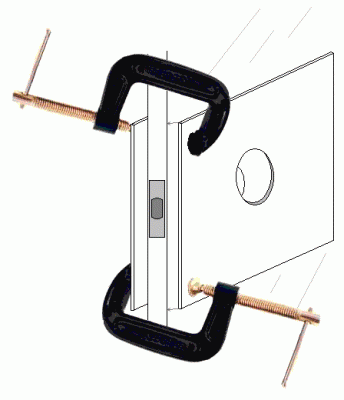
Redrilling a Door
Years
ago the standard size for a cross bore was 1 ½ in diameter.
In order to include baffles and some other features the standard has
changed to 2 1/8 in the last few years. If
you are replacing an older lock with a newer one, that can be a problem.
There are also cases where you might want to change the backset from 2
3/8 to 2 ¾ or vice versa. Making
either one of those changes can be problematic if you dont have an
installation jig and those jigs typically have a price tag of hundreds of
dollars.
There
is a simpler solution that will typically be good for one or two uses before you
need to make a new one. The tools
you will need are:
The
first step is to measure from one edge of one of the plywood sheets to the
center of the backset you want to put into the door.
Then use the hole saw to cut a hole in the plywood at that backset.
Clamp the plywood sheet to the door in the proper location using the two
C-clamps and the undrilled plywood to avoid damaging the door.
The
next step is to remove the lead bit from the hole saw.
Then place the hole saw into the hole in the plywood and carefully start
the drill and push the saw toward the door.
Be careful to not have the saw touching the door yet when you start the
drill as it could bite too deeply into the door and possibly cause damage to the
door, or to you, if you dont have a firm grip on the drill.
As
you drill through the door the hole saw will encounter the other sheet of
plywood and having it there will prevent the saw from tearing the surface finish
of the door when it breaks through. If
your door has a grainy surface you may want to use the added precaution of
covering that surface with masking tape as well to prevent tearing when the saw
breaks through. If you tape the
door, always remove the tape after drilling by pulling it toward the hole, never
away from the hole.
To
use the template on another door, just remember to use an undrilled area of that
inside sheet of plywood.
Copyright © 2012, Thelockman LLC. ALL rights reserved